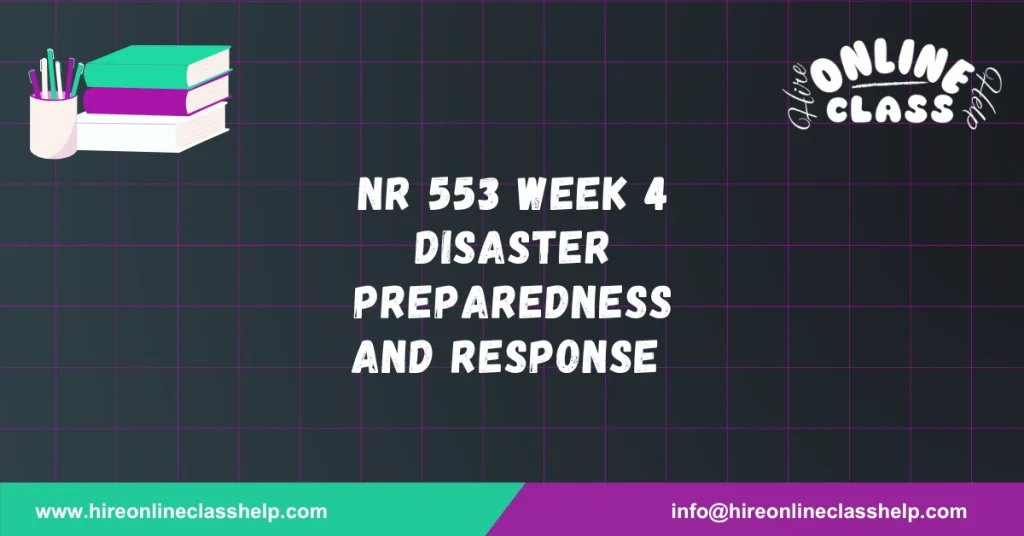






Name
Chamberlain University
NR-553: Global Health
Prof. Name
Date
Disasters—whether natural or man-made—disrupt healthcare systems and challenge providers’ ability to deliver timely and effective care. Nurses, as the largest segment of the global healthcare workforce, play a central role in disaster preparedness and response. According to Veenema et al. (2016), nurses must be engaged not only as responders but also as leaders, educators, and policy advocates. However, nursing preparedness efforts remain inconsistent worldwide, including in the United States, leaving significant gaps in readiness. Strengthening nurses’ involvement in disaster management is essential to ensure healthcare resilience and effective surge capacity during emergencies.
The International Committee of the Red Cross (ICRC) is a globally recognized humanitarian organization that provides aid during armed conflicts, natural disasters, and other emergencies. Established under the Geneva Conventions of 1949 and guided by international humanitarian law, the ICRC’s mission focuses on protecting lives, preserving human dignity, and delivering essential healthcare and relief services (International Committee of the Red Cross [ICRC], n.d.).
The ICRC operates in regions severely affected by disasters and conflicts, offering direct medical assistance, public health education, disaster risk reduction, and humanitarian relief. Its neutrality and independence allow it to function effectively in areas with limited access, ensuring that aid reaches the most vulnerable populations.
Nurses are crucial in achieving the ICRC’s healthcare and humanitarian goals. Their work extends beyond clinical care to include leadership, advocacy, education, and capacity-building efforts. The table below outlines their contributions in detail.
Roles of Nurses within the International Committee of the Red Cross (ICRC)
| Role | Description |
|---|---|
| Direct Care | Provide first aid, trauma management, and distribute essential medications to victims. |
| Health Education | Educate communities about hygiene, disease prevention, and self-care after crises. |
| Leadership | Contribute to developing disaster policies and strengthening local health response systems. |
| Capacity Building | Train local healthcare personnel in emergency response and preparedness strategies. |
| Psychosocial Support | Deliver trauma recovery assistance and mental health support to survivors. |
Through these multifaceted roles, nurses enhance both immediate response effectiveness and long-term community recovery.
Nurses can further expand their influence in disaster preparedness by assuming broader roles in policy development, disaster simulation exercises, and international collaboration. For instance, they can:
Conduct research to identify best practices and assess disaster response interventions.
Collaborate with governments and non-governmental organizations (NGOs) to incorporate nursing expertise into national disaster frameworks.
Develop community-based preparedness programs that empower residents to respond efficiently during crises.
By integrating nurses into decision-making and leadership bodies, healthcare systems can ensure that clinical expertise shapes policy and resource allocation, leading to stronger, evidence-based disaster responses.
Hi Carole,
Thank you for highlighting the important work of the ICRC. Like you, I previously associated the Red Cross primarily with national organizations, but learning about its global humanitarian scope has broadened my understanding. Your discussion about the pivotal role of nurses in disaster preparedness aligns with my own findings.
According to Couig et al. (2017), progress on Veenema’s “Call to Action” emphasizes the efforts of the Society for the Advancement of Disaster Nursing (SADN), which has developed recommendations in research, education, and practice to strengthen nursing participation in disaster preparedness. However, despite these advances, local-level policy influence for nurses remains limited.
As a nurse with critical care experience, I recognize the importance of structured residencies and certifications that help nurses transition into disaster leadership roles effectively.
Dr. Fildes and Christie,
Your observations on the limited visibility of nurses in disaster leadership are critical. Strengthening nursing involvement should begin in undergraduate education and continue through ongoing professional development. The American Nurses Association (ANA) (n.d.) recommends that registered nurses obtain specialized disaster preparedness training and certification to maintain current and effective skills.
Additionally, the ANA encourages participation in volunteer registries such as the Medical Reserve Corps (MRC) and the Disaster Medical Assistance Teams (DMATs), which provide structured pathways for credentialing, training, and deployment during emergencies (Medical Reserve Corps [MRC], 2018).
In my local context, I would collaborate with public health departments, MRC units, and NGOs to organize joint disaster drills, ensuring that nurses are fully integrated into community emergency response efforts. Such collaborations would not only enhance nursing leadership but also improve overall community resilience.
Penny,
Thank you for your dedicated service as a military nurse. The U.S. military has long demonstrated leadership in disaster preparedness and humanitarian aid, notably during the 2010 Haiti earthquake and Hurricane Katrina in 2005 (Born et al., 2011). Military nurses act as first responders, combining clinical proficiency with operational coordination.
As Slepski (2005) emphasized, emergency preparedness requires comprehensive knowledge, skills, and actions to manage complex incidents effectively. Through initiatives like the Homeland Security Grant Program (HSGP), the U.S. Department of Homeland Security (DHS) continues to support disaster readiness through funding for training, equipment, and coordinated response (Department of Homeland Security [DHS], 2018).
Nurses within military healthcare are uniquely positioned to lead these initiatives, bridging the gap between clinical care delivery and national preparedness strategies.
American Nurses Association. (n.d.). Disaster preparedness. https://www.nursingworld.org/practice-policy/work-environment/health-safety/disasterpreparedness/
Born, C. T., Dean, J. C., Hayda, R. A., McSwain, N. E., Riddles, M., & Shimkus, L. (2011). The military response to the Haitian earthquake of 2010: Lessons for future humanitarian disasters. Journal of the American Academy of Orthopaedic Surgeons, 19(S1), S43–S49. https://doi.org/10.5435/00124635-201102001-00009
Couig, M. P., Gable, A., Griffin, A., Langan, J. C., Katzburg, J. R., Wolgast, K. A., & Veenema, T. G. (2017). Progress on a call to action: Nurses as leaders in disaster preparedness and response. Nursing Administration Quarterly, 41(2), 112–117. https://doi.org/10.1097/NAQ.0000000000000226
Department of Homeland Security. (2018). Homeland Security Grant Program. https://www.fema.gov/homeland-security-grant-program
International Committee of the Red Cross. (n.d.). Mandate and mission. https://www.icrc.org/en/who-we-are/mandate
Medical Reserve Corps. (2018). About the Medical Reserve Corps. https://mrc.hhs.gov/pageviewfldr/About
Slepski, L. A. (2005). Emergency preparedness: Concept development for nursing practice. The Nursing Clinics of North America, 40(3), 419–430. https://doi.org/10.1016/j.cnur.2005.04.005
Veenema, T. G., Griffin, A., Gable, A. R., MacIntyre, L., Simons, R. A. D. M., Couig, M. P., & Larson, E. (2016). Nurses as leaders in disaster preparedness and response—A call to action. Journal of Nursing Scholarship, 48(2), 187–200. https://doi.org/10.1111/jnu.12198